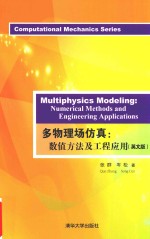

多物理场仿真 数值方法及工程应用 英文版PDF电子书下载
- 电子书积分:14 积分如何计算积分?
- 作 者:张群,岑松著
- 出 版 社:北京:清华大学出版社
- 出版年份:2016
- ISBN:7302450764
- 页数:424 页
1 The physics models 1
1.1 Heat flow fundamentals 2
1.2 Fluid dynamics 6
1.3 Structural mechanics 26
1.4 Electromagnetic field 59
1.5 Acoustic analysis 93
2 Physics coupling phenomena and formulations 97
2.1 Introduction to coupling problems 98
2.2 General coupling equations 98
2.3 Types of coupling interfaces 102
2.4 Classification of coupling phenomena 103
2.5 The coupling matrices among physics models 104
2.6 Thermal-stress coupling 104
2.7 Fluid-structure interaction 107
2.8 Conjugate heat transfer problem 112
2.9 Acoustic-structure coupling 113
2.10 Piezoelectric analysis 115
2.11 Electrostatic-structure coupling 116
2.12 Magneto-structure coupling 116
2.13 Magneto-fluid coupling 117
2.14 Electrothermall coupling 118
2.15 Magnetic-thermal coupling 120
2.16 Summary of the coupling types 120
3 The coupling methods 125
3.1 Introduction to coupling methods 125
3.2 The strong coupling method 126
3.3 Weak coupling methods 133
3.4 Comparisons of the strong and weak coupling methods 151
3.5 Time integration scheme for transient multiphysics problems 152
4 Nonstructural physics with moving boundary 157
4.1 The moving domain problem in multiphysics simulation 157
4.2 Advanced morphing method 159
4.3 Automatic remeshing technology 160
4.4 Mesh controls for rotating machinery 164
4.5 Treatment for pinched flow problems 167
4.6 Examples for mesh control 167
5 Stabilization schemes for highly nonlinear problems 177
5.1 An overview of stabilization methods 177
5.2 Stabilization methods in spatial domain 178
5.3 Stabilization in the time integration scheme 191
5.4 Underrelaxation of the solution vector 197
5.5 Capping for the solution 198
5.6 Trade off the stability,accuracy,and efficiency 199
6 Coupling simulation for rotating machines 201
6.1 Reference frames 201
6.2 General coupling boundary conditions 203
6.3 Governing equations in body-attached rotating frame 209
6.4 Multiple frames of references for rotating problems 210
6.5 Morphing technology for rotating problems 219
6.6 Multiphysics simulation for rotating machines 220
7 High-performance computing for multiphysics problems 227
7.1 The challenges in large-scale multiphysics simulation 227
7.2 Parallel algorithm for the strong coupling method 228
7.3 Parallel scheme for weak coupling methods 230
8 General multiphysics study cases 233
8.1 Efficiency studies of strong and weak coupling methods for simple case 233
8.2 Fluid-structure interaction simulation of flow around a cylinder with a flexible flag attached 237
8.3 Fluid-structure simulation of a flapping wing structure in a water channel 245
9 Multiphysics applications in automotive engineering 251
9.1 The study of dynamic characteristics of hydraulic engine mounts by strong coupling finite element model 251
9.2 Weak coupling fluid-solid-thermal analysis of exhaust manifold 267
9.3 Coupling analysis of permanent magnet synchronous motor 273
10 Computational fluid dynamics in aerospace field and CFD-based multidisciplinary simulations 295
10.1 Application and development of computational fluid dynamics simulation in the aerospace field 295
10.2 The research topic and its progress 297
10.3 Example 310
11 Multiphysics simulation of microelectro-mechanical systems devices 329
11.1 Introduction to MEMS 329
11.2 Micropump 329
11.3 Natural convection cooling of a microelectronic chip 334
12 Bidirectional multiphysics simulation of turbine machinery 339
12.1 The fluid-structure-thermal bidirectional coupling analysis on the rotor system of turbo expander 339
12.2 The fluid-structure coupling analysis of the turbine blade 349
13 Multiphysics modeling for biomechanical problems 363
13.1 Numerical analysis of a 3D simplified artificial heart 363
13.2 FSI simulation of a vascular tumor 366
14 Other multiphysics applications 375
14.1 FSI simulation of a sensor device in civil engineering 375
14.2 Acoustic structural coupling case 381
15 Code implementation of multiphysics modeling 387
15.1 Overview of commercial CAE software for multiphysics 387
15.2 Code implementation for multiphysics modeling 389
References 397
Index 409
- 《中风偏瘫 脑萎缩 痴呆 最新治疗原则与方法》孙作东著 2004
- 《卓有成效的管理者 中英文双语版》(美)彼得·德鲁克许是祥译;那国毅审校 2019
- 《基于地质雷达信号波的土壤重金属污染探测方法研究》赵贵章 2019
- 《第一性原理方法及应用》李青坤著 2019
- 《FDS火灾数值模拟》李胜利,李孝斌编著 2019
- 《新编高中物理竞赛教程习题全解》钟小平主编;钟小平,倪国富,曹海奇编写 2019
- 《数学物理方法与仿真 第3版》杨华军 2020
- 《Helmholtz方程的步进计算方法研究》李鹏著 2019
- 《中学物理奥赛辅导:热学 光学 近代物理学》崔宏滨 2012
- 《长江口物理、化学与生态环境调查图集》于非 2019
- 《中风偏瘫 脑萎缩 痴呆 最新治疗原则与方法》孙作东著 2004
- 《水面舰艇编队作战运筹分析》谭安胜著 2009
- 《王蒙文集 新版 35 评点《红楼梦》 上》王蒙著 2020
- 《TED说话的力量 世界优秀演讲者的口才秘诀》(坦桑)阿卡什·P.卡里亚著 2019
- 《燕堂夜话》蒋忠和著 2019
- 《经久》静水边著 2019
- 《魔法销售台词》(美)埃尔默·惠勒著 2019
- 《微表情密码》(波)卡西亚·韦佐夫斯基,(波)帕特里克·韦佐夫斯基著 2019
- 《看书琐记与作文秘诀》鲁迅著 2019
- 《酒国》莫言著 2019
- 《大学计算机实验指导及习题解答》曹成志,宋长龙 2019
- 《指向核心素养 北京十一学校名师教学设计 英语 七年级 上 配人教版》周志英总主编 2019
- 《大学生心理健康与人生发展》王琳责任编辑;(中国)肖宇 2019
- 《大学英语四级考试全真试题 标准模拟 四级》汪开虎主编 2012
- 《大学英语教学的跨文化交际视角研究与创新发展》许丽云,刘枫,尚利明著 2020
- 《北京生态环境保护》《北京环境保护丛书》编委会编著 2018
- 《复旦大学新闻学院教授学术丛书 新闻实务随想录》刘海贵 2019
- 《大学英语综合教程 1》王佃春,骆敏主编 2015
- 《大学物理简明教程 下 第2版》施卫主编 2020
- 《指向核心素养 北京十一学校名师教学设计 英语 九年级 上 配人教版》周志英总主编 2019
